About Spinosaurus
| Scientific Name (Genus) | Spinosaurus |
| Meaning of Name |
Spined lizard
spīna (spine) [Latin] - saurus (lizard) [Greek] |
| Classification | Saurischia, Theropoda (Tetanurae, Spinosauridae) |
| Total Length | Approx. 13 - 15m |
| Diet | Piscivorous |
| Period | Early to Late Cretaceous |
| Species |
Spinosaurus aegyptiacus
Spinosaurus maroccanus (dubious name) |
| Year of Paper Publication | 1915 |
| Description Paper |
Ergebnisse der Forshungsreisen Prof. E. Stromers in den Wüsten Ägyptents.
Wirbeltier-Reste der Baharîe-Stufe(unterstes Cenoman) 3.Das Original des Theropoden Spinosaurus aegyptiacus, von Ernst Stromer, Vorgelegt am 6, Nov. 1915. |
Features: The Ever-Changing Largest Carnivorous Dinosaur
Spinosaurus was one of the largest carnivorous dinosaurs in history, even surpassing Tyrannosaurus. It reached a length of over 13 meters. The features of Spinosaurus are its long sail on its back and its long, narrow snout resembling that of a crocodile. The sail on its back reached a height of 2 meters at its longest point. Its appearance has continued to change more dramatically than any other dinosaur due to a series of recent discoveries. Once thought to be a terrestrial predator, it is now certain that it was a dinosaur highly adapted to an aquatic lifestyle.
Its long, narrow snout, equipped with sensors at the tip like a crocodile's, and its conical teeth, suitable for catching fish, indicate that it was piscivorous.
The Forefront of Controversy: Evolution into an Aquatic Dinosaur
The debate over whether Spinosaurus was aquatic has been one of the hottest topics in paleontology since 2014.
2014: The Aquatic Adaptation Hypothesis is Proposed
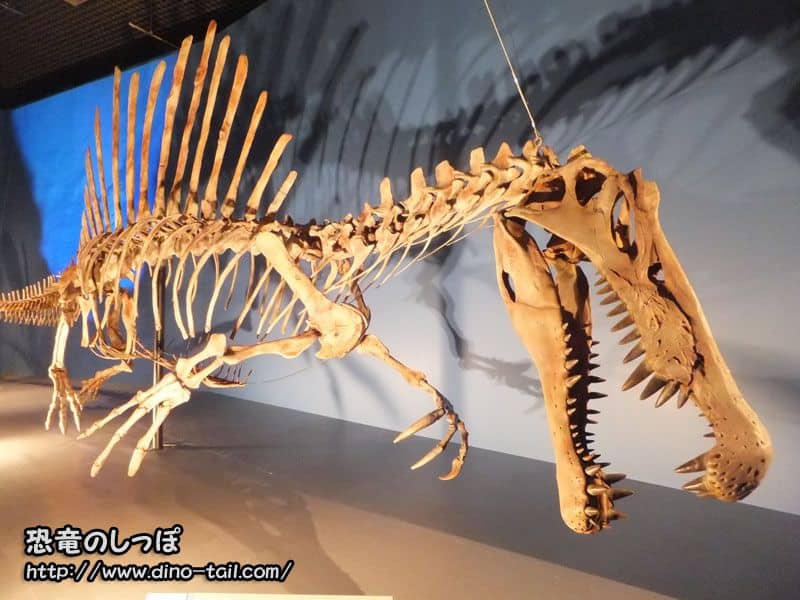
In 2014, a research team led by Dr. Nizar Ibrahim announced, based on new fossils discovered in Morocco, that Spinosaurus had remarkably short hind limbs and a bone density similar to that of aquatic animals. They proposed the revolutionary theory that it 'lived primarily in the water.' However, this theory was met with counterarguments, such as 'the shape of the tail, which would have generated propulsion, is unknown.'
2020: Discovery of a Paddle-Like Tail
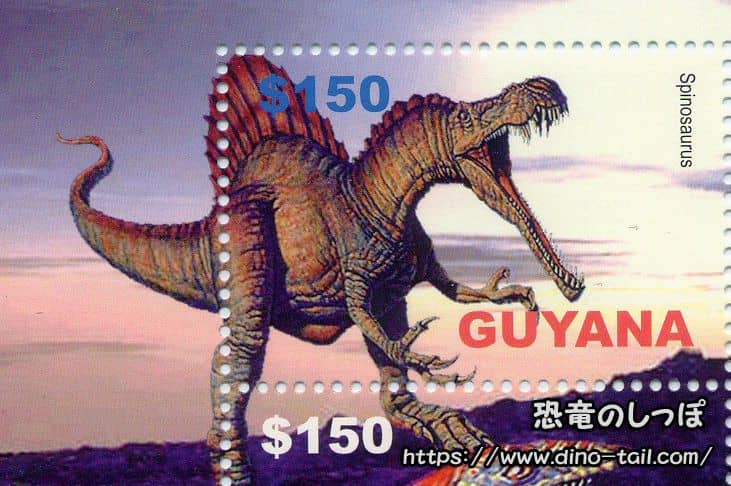
This counterargument was overturned by the discovery of the tail fossil of the same specimen, announced in 2020. Its tail was not long and slender like that of other theropods, but had a huge, 'paddle-like' shape with several tall, developed neural spines . This was irrefutable evidence that it generated propulsion to move powerfully through the water by swinging its tail from side to side.
2022: The Decisive Evidence? Penguin-Like Bones
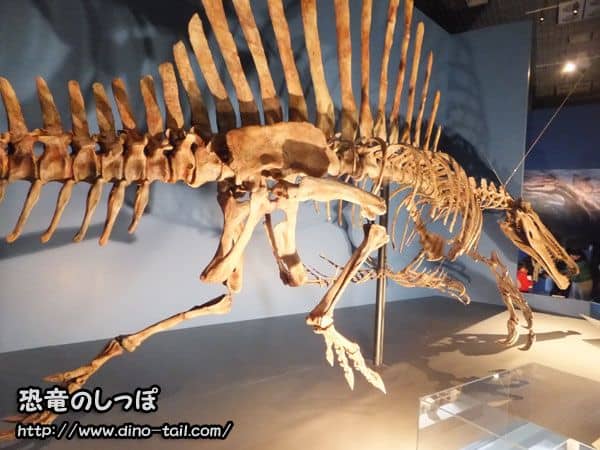
Short hind limbs
Furthermore, in 2022, the research team showed that the bone density of Spinosaurus was very similar to that of diving animals like penguins, hippos, and crocodiles, with dense, heavy bones . This means that it functioned as a 'ballast' to reduce buoyancy and allow it to dive. These discoveries have established a new image of the dinosaur as an 'aquatic pursuit predator' that not only waited for fish by the water's edge but also actively swam and pursued its prey in the water.
It has also become clear that the hind limbs of Spinosaurus were significantly shorter than those of other large theropods.
While the center of gravity of typical theropods was in the rear, supporting most of their weight on their hind limbs, it seems that Spinosaurus was ill-suited to supporting its weight on its hind limbs alone.
The Role of the Sail (Neural Spines)
The role of the sail on its back has also been shed new light on by this aquatic theory. The previously thought thermoregulatory function has been refuted, and the most promising theory now is that, in addition to its role as a display to its own kind, it also served as a 'vertical stabilizer' to maintain the body's stability in the water.
Numerous Pits on the Tip of Spinosaurus's Snout

There are many pits on the tip of the snout.
It served as a sensor to detect fish, its food.
Isotope analysis of tooth fossils conducted in 2009 showed that the oxygen isotope ratio of Spinosaurus teeth was close to that of turtles and crocodiles, suggesting the possibility that it was semi-aquatic (living both in water and on land). In 2014, a research team from the University of Chicago and other institutions re-examined the research results and proposed the theory that 'Spinosaurus was adapted to an aquatic lifestyle.'
By digitizing the fossil specimens and examining the skeletal structure, they found that it had 'bone density suitable for buoyancy' and a 'nose suitable for spending time in the water.'
There were many pits on the tip of Spinosaurus's snout. This is a feature also seen in modern crocodiles.
It is thought that the nervous system at the tip of the snout was well-developed and served as a sensor to detect fish, its food, even in murky water.
The Role of the Sail (Neural Spines) - 'Thermoregulation' Theory Refuted
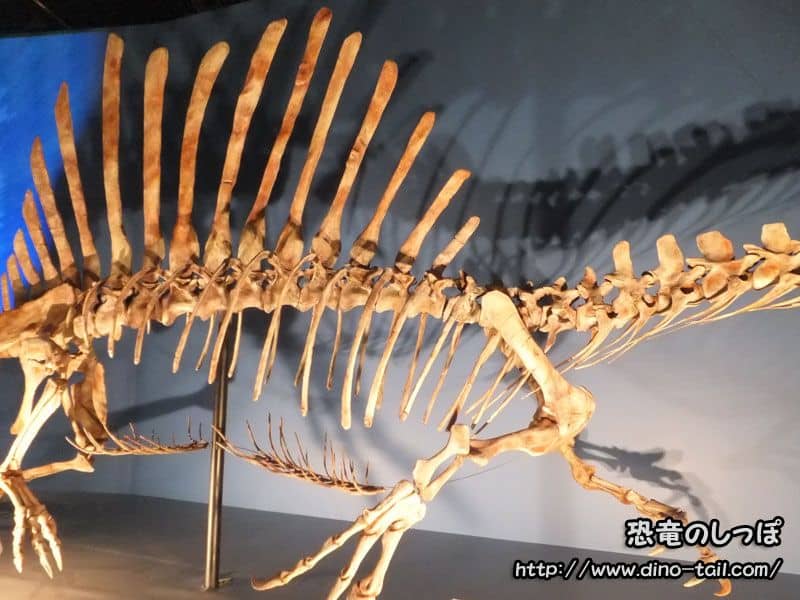
Regarding the role of the sail (neural spines) on its back, the following theories were once proposed:
- Thermoregulation
- Display (for intimidation or attracting mates)
- Posture control in the water
When Spinosaurus was first reconstructed, it was thought that the sail (neural spines), like the plates on the back of the thyreophoran Stegosaurus, served a thermoregulatory function. However, detailed examination of the surface and cross-section of the sail (neural spines) revealed no traces of blood vessels like those seen in Stegosaurus, so the 'thermoregulation' theory is now refuted.
Currently, the 'display for intimidation or attracting mates' theory and the 'function to stabilize posture in buoyant water' theory are considered the most plausible.
Spinosaurus in an Air Raid
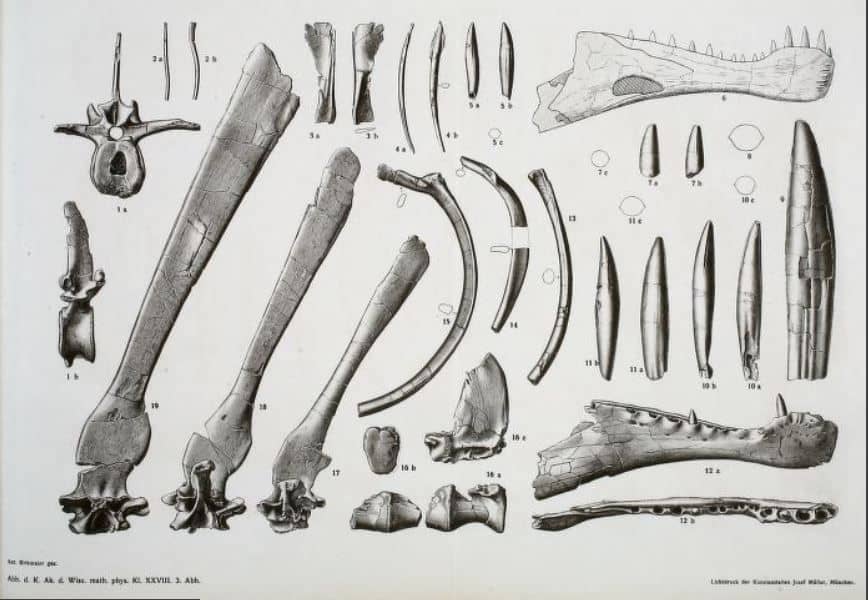
Source: Ergebnisse der Forshungsreisen Prof. E. Stromers in den Wüsten Ägyptents. Wirbeltier-Reste der Baharîe-Stufe(unterstes Cenoman) 3.Das Original des Theropoden Spinosaurus aegyptiacus, von Ernst Stromer, Vorgelegt am 6, Nov. 1915.
In 1912, the German paleontologist Ernst Stromer discovered a giant dinosaur in the Bahariya Formation in western Egypt. The lower jaw, teeth, cervical, dorsal, and caudal vertebrae were excavated, and in 1915, he named and announced it as 'Spinosaurus' (spined lizard). This is the type species 'Spinosaurus aegyptiacus,' based on specimen number BSP 1912 VIII 19.
Due to its unusual appearance and size for a dinosaur known at the time, the name Spinosaurus became widely known, and in 1936, Stromer published a reconstruction of the complete skeleton.

In 1944, as the war spread to Germany, Stromer proposed that the Spinosaurus fossils he had brought back from Egypt be moved to a safe place, but his proposal was not accepted, and the specimen, which was housed in the Bavarian State Collection of Paleontology and Geology in Germany, was destroyed in an Allied air raid on April 24, 1944.
In 1996, a middle cervical vertebra believed to be from Spinosaurus was found in the Kem Kem Beds in Morocco. This specimen, number NMC 50791, is the holotype of 'Spinosaurus maroccanus' and is 19.5 cm long. Since then, until a well-preserved Spinosaurus fossil was found in 2013, it was called the 'mystery dinosaur.'
In recent years, a large number of tooth fossils have been excavated from Morocco, and Spinosaurus teeth can be obtained at a low price.
